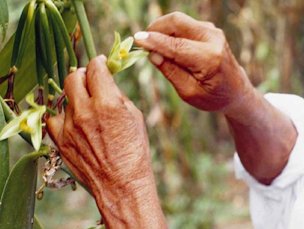Article from
VSCNews, Vegetable and Specialty Crop News
by Brad Buck
UF/IFAS Hopes to Grow Vanilla, Meet Consumer Demand

Manual pollination of Vanilla planifolia
GAINESVILLE,
Fla. — For dessert, how about a scoop of ice cream flavored with
vanilla from Florida’s farmers? Because so many consumers enjoy
vanilla, University of Florida scientists hope to help Florida farmers
grow the bean.
Consumers have an appetite for vanilla. The U.S.
leads the world in imported vanilla beans, said Alan Chambers, an
assistant professor of horticultural sciences at the UF Institute of
Food and Agricultural Sciences. Madagascar grows about 80 percent of
the world’s vanilla, but that island lies thousands of miles from the
companies that buy vanilla beans and convert them to extract, Chambers
said.
That’s all the more reason UF/IFAS wants to see if Vanilla can be grown commercially in Florida.
“Everything we could grow would be consumed,” said Chambers. “We believe the market is there. It’s got huge potential.”
“There
are only a few places in the U.S. with favorable conditions to grow
vanilla on a commercial scale, and South Florida is one that has
several advantages,” said Elias Bassil, also a UF/IFAS assistant
professor of horticultural sciences who’s working with Chambers on the
Vanilla research.
Chambers and Bassil, both faculty members at
the UF/IFAS Tropical Research and Education Center in Homestead,
Florida, are trying to connect the genetic and physiological dots to
help South Florida farmers eventually grow vanilla.
Chambers
researches genetics and breeding, and Bassil studies vanilla physiology
and biotechnology to understand how the plants respond to common
environmental stresses.
The scientists are studying vanilla genetics so they grow the best beans.
Chambers
has brought over 100 accessions to his lab. Accessions are types of
plant material from which a scientist can select those genes needed to
produce ideal Vanilla cultivars.
“We are mining the genetic
diversity represented in our collection in order to find those key
genes that underlie the most important traits associated with superior
quality and productive vines,” said Bassil. “We have several modern
biotechnological tools at our disposal to achieve this.”
Chambers
sees potential to breed new Vanilla cultivars fit for farmers to
produce plenty of the crop. He also hopes to breed great-tasting
vanilla.
“Vanilla has global appeal, but lacks the foundational
research that led to superior crops cultivars such as apples,
strawberries, tomatoes, wheat and most other food crops,” Chambers
said. “We don’t even know what we’ll find when we start looking for new
traits and fruit qualities. Therefore, the true genetic potential of
Vanilla is still enigmatic, and vanilla science could be at the very
foundation of new and exciting future possibilities to delight
consumers with novel sensory attributes from vanilla-based products.”
For now, those who grow Vanilla in South Florida are hobbyists.
“We
have growers and homeowners interested in producing vanilla, but we
don’t have scientifically validated information and accessible
resources available yet,” Chambers said.
That’s why Chambers and
Bassil caution that even if they can develop a vanilla bean that grows
well in local conditions, farmers would cultivate it as a secondary
crop.
The two scientists envision many domestic opportunities
for vanilla growers, including local, organic, domestically grown,
niche quality opportunities like novel flavor combinations and
added income through tourism.
With Vanilla, Chambers draws comparison to the origins of other UF/IFAS breeding programs.
“But
we’re just getting started,” he said. He compared the scientists’
experimentation with blueberries 50 years ago or strawberry 100 years
ago in Florida. “At least UF/IFAS has a history of crop establishment
and supporting new, promising species.”
Brad Buck, University of Florida Institute of Food and Agricultural Sciences
|
|
Bibliography
Buck, Brad. "UF/IFAS Hopes to Grow Vanilla, Meet Consumer Demand." Vegetable and Specialty Crop News, 12 June 2018,
vscnews.com/uf-ifas-hopes-grow-vanilla-meet-consumer-demand/.
Accessed 14 Dec. 2019.
Photograph
"Manual pollination of Vanilla planifolia." Food and Agriculture Organization of the United Nations, FAO, www.fao.org/3/a-ax447e.pdf. Accessed 14 Dec. 2019.
Published 14 Dec. 2019 LR
|
